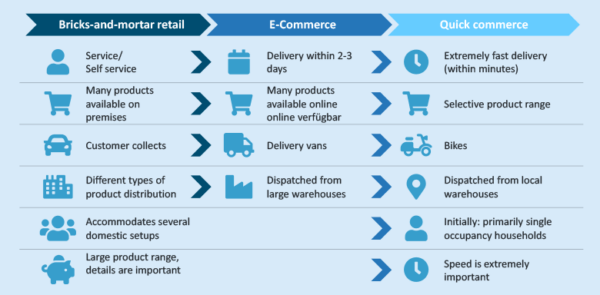
Quick commerce is a digital revolution that can give your customers an even better shopping experience. However, if you really want to succeed in the fast-paced and competitive q-commerce market, you need to do some thorough groundwork. In this article, we will be taking a look at some of the key principles in quick commerce. Join us for the ride and become an expert on quick commerce, too!
Take a look at the second part of this series to discover the challenges and opportunities in q-commerce.
What is Quick Commerce? A Definition of Q-commerce
Q-commerce is the short form for quick commerce. Considered to be the third generation of trade, it is a new type of e-commerce. As the name suggests, in an already fast-paced world of e-commerce, q-commerce is about an exceptionally fast delivery of products and services. Sales are made exclusively over the Internet. Products usually get to the customer minutes, at most hours, after the order is placed. However, this can only happen if all the processes and systems behind this are seamlessly integrated and operate in real time.
What’s the difference between e-commerce and q-commerce?
Let’s not get ahead of ourselves yet. At first glance, q-commerce may seem like just a faster version of e-commerce. However, a closer look shows they differ significantly in detail. The biggest differences are in delivery time, warehousing, product availability and choice, and transportation.¹
- While e-commerce calculated the delivery time in days, q-commerce requires the product reach the customer within hours – or even minutes.
- E-commerce uses central warehouses, which are generally on the outskirts of a town or city, where costs are lower. However, the delivery speed in q-commerce means that their warehouses need to be smaller, distributed, and strategically placed, close to customers. You will often find these dark stores in city centres, or even in residential areas.
- The warehousing approach in q-commerce influences product availability and the size of the product range. In e-commerce, sellers can offer a wide range of products as these don’t need to be immediately available at order. Instead, they can be internally ordered from a less local warehouse and still reach the customer within the delivery timeframe. In q-commerce, the product range is significantly smaller and depends on the size of the local warehouse. However, everything in that small selection is immediately available.
- Q-commerce and e-commerce also take different approaches to transport. While e-commerce orders are usually delivered by delivery trucks or commercial parcel services, q-commerce tend to rely on smaller, more manoeuvrable vehicles such as bicycles or motorbikes. This ensures that couriers can reach warehouses and delivery addresses quickly, even with traffic congestion.

How does quick commerce work?
As soon as the supplier receives an order, the product is immediately packed and dispatched. This means that logistics plays a pivotal role. The online sales platform needs to be synchronized with a warehouse management system (WMS) so that orders can be checked against actual availability in real time.
How did quick commerce start?
Q-commerce originally arose as a complement to conventional retail, making it possible to rapidly deliver essential products such as food, medicine and hygiene products in primarily urban areas. However, q-commerce really came to public attention in the COVID-19 lockdowns. Suddenly, online orders exploded and prompt delivery became essential. For some companies, this development has led to q-commerce becoming an integral part of the business strategy. We can safely assume that q-commerce will extend to other retail sectors in the near future.
The rise of q-commerce
Originally, q-commerce only delivered food. Now, it also deals with other products such as medicines, gifts and clothing. Nevertheless, food deliveries is still responsible for the majority of the revenue in today’s q-commerce business.
Q-commerce began its triumphant advance in the metropolises of North America and Asia. The first q-commerce companies emerged as early as 2011, with the industry really gaining in importance from 2017. In countries such as the USA, South Korea and India, q-commerce has already become an integral part of online retail.
The rise of q-commerce in Germany
In Germany, the COVID 19 pandemic gave q-commerce a particular boost. Due to the increasing number of start-ups entering the q-commerce market, even established online suppliers were quickly forced to offer delivery times of less than 20 minutes in order not to lose their customers to the competition. Lockdowns, as well as people wishing to avoid crowded places, did the rest to turn q-commerce mainstream.
The potential of quick commerce in Germany, and current trend
In Germany, the potential of q-commerce remains high. Due to the necessary decentralised warehousing with short delivery routes, q-commerce is only feasible in cities of a certain size. In Germany there are about 40 cities of over 200,000 inhabitants, This represents an interesting market for q-commerce companies. At 21 million inhabitants, this sector corresponds to a quarter of the German population. It is therefore to be expected that q-commerce will become more established in Germany, especially around cities.
How q-commerce has changed the face of shopping
Once customers have experience a certain level of convenience, they are reluctant to give it up. Online retail continues to win out over traditional retail, and q-commerce will play an increasingly important role in this. Indeed, q-commerce is the future of shopping. By combining fast shipping, easy payment and a constantly evolving product range, q-commerce will continue to revolutionize shopping for many people.
If you want to know more about the benefits and challenges of q-commerce and how to technically implement this, take a look at the second part of our q-commerce series.
Nearly all use cases in q-commerce require real-time connectivity for all of your systems. The API capabilities on the SEEBURGER Business Integration Suite lets you rise above your competitors by giving you connectivity and flexibility in an operating model that best fits your needs.
Source: https://blog.seeburger.com/quick-commerce-101/
 expertise
expertise
